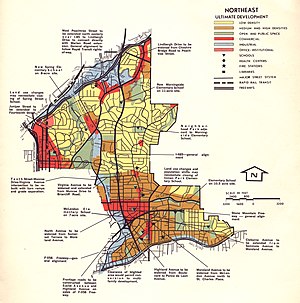Interstate 485 (I-485) was a proposed auxiliary Interstate Highway that would have traveled eastward and then northward from Downtown Atlanta, in the US state of Georgia.
 1970 map of the proposed route of I-485 through northeast Atlanta | ||||
| Route information | ||||
| Auxiliary route of I-85 | ||||
| Length | 5.9 mi[1] (9.5 km) | |||
| Existed | 1964[citation needed]–1975[2] | |||
| NHS | Entire route | |||
| Location | ||||
| Country | United States | |||
| State | Georgia | |||
| Counties | Fulton | |||
| Highway system | ||||
| ||||
| ||||
| ||||
Route description edit
The 5.9-mile-long (9.5 km)[1] route would have begun at the Downtown Connector (I-75/I-85) and used the highway that is nowadays State Route 410 (SR 410) east to the interchange with the also-proposed SR 400. There, it would have turned north to end at I-85 near SR 236 (Lindbergh Drive). Each of those freeways would have continued beyond the termini of I-485. SR 410, the Stone Mountain Freeway, would continue east beyond the I-285 perimeter highway, and SR 400 would extend both south and north outside the perimeter. A short piece of I-485/SR 410 was constructed from I-75/I-85 east to Boulevard Northeast.[3]
History edit
Activists in the neighborhood of Morningside, along the SR 400 portion of I-485, were the first to fight the road, although opposition surfaced in a number of nearby surrounding neighborhoods. This is the most famous example of the Atlanta freeway revolts.[4] After I-485, and parts of SR 400 and SR 410, was canceled, a portion of the right-of-way of the canceled highway was used to build Freedom Parkway, now part of SR 10. SR 400 north of I-85 was constructed in the early 1990s as a toll road,[5] and the section south of I-285 was constructed in the mid-1980s and designated I-675.[6][7]
See also edit
References edit
- ^ a b "Part V - Interstate Withdrawal-Substitution Program - Engineering Data - Interstate System - Highway History". Federal Highway Administration. Retrieved July 15, 2016.
- ^ Georgia Department of Transportation (January 1975). Official Highway Map (PDF) (Map) (1975–1976 ed.). Scale not given. Atlanta: Georgia Department of Transportation. Retrieved July 30, 2016.
- ^ Georgia Department of Transportation (January 1973). Official Highway Map (PDF) (Map). Scale not given. Atlanta: Georgia Department of Transportation. Retrieved October 20, 2013.
- ^ Wheeler, James O. (1976). "Locational Dimensions of Urban Highway Impact: An Empirical Analysis". Geografiska Annaler: Series B, Human Geography. 58 (2). Blackwell Publishing on behalf of the Swedish Society for Anthropology and Geography: 67–78. doi:10.1080/04353684.1976.11879413. JSTOR 490613.
- ^ Georgia Department of Transportation (1995). Official Highway and Transportation Map (PDF) (Map) (1995–1996 ed.). Scale not given. Atlanta: Georgia Department of Transportation. Retrieved July 12, 2016.
- ^ Georgia Department of Transportation (1986). Official Highway and Transportation Map (PDF) (Map) (1986–1987 ed.). Scale not given. Atlanta: Georgia Department of Transportation. Retrieved July 15, 2016.
- ^ Georgia Department of Transportation (1987). Official Highway and Transportation Map (PDF) (Map) (1987–1988 ed.). Scale not given. Atlanta: Georgia Department of Transportation. Retrieved July 15, 2016.
External links edit
- Media related to Interstate 485 (Georgia) at Wikimedia Commons
- Interstate 485 Georgia on Interstate-guide.com
- The canceled I-485 route (superimposed on Google Maps)
